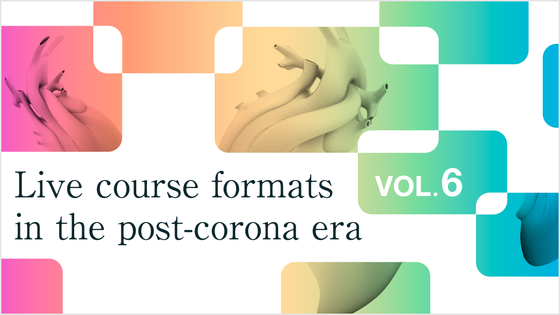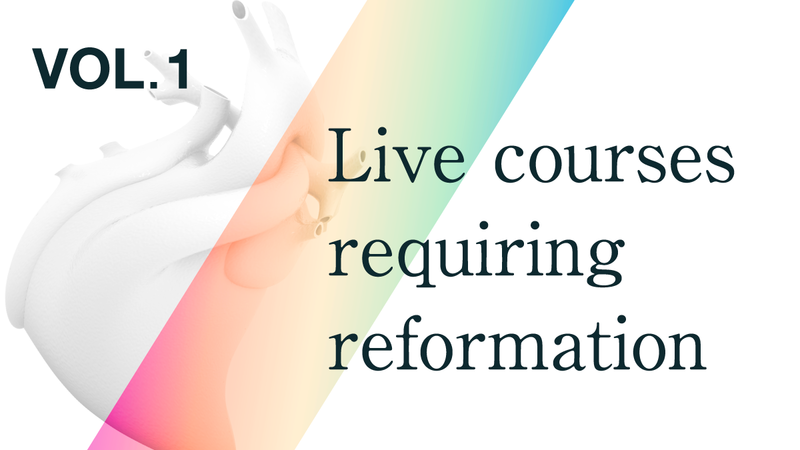A Japanese man who developed a fever while staying in Wuhan returned to Japan on January 6th where he was diagnosed as having the flu. He continued recuperating at home but by January 13th his symptoms had not improved. On January 14th, the public health center took administrative action and by January 16th, WHO announced the first domestic case of coronavirus in Japan.3 Only a few months after the case was reported, the situation escalated into the global pandemic we refer to it as today.
On February 14th-16th, 2020, live courses and conferences in the catheterization industry organized by EuroPCR were held at Tokyo Valves, but the following week, the Japan Endovascular Treatment (JET) Conference 2020 was postponed. Chugoku-Shikoku Live in Kurashiki (February 28th-29th, 2020) was also postponed, and Kanazawa Coronary Conference (KCC), which was originally scheduled for March 20th, was cancelled. In March, the Japanese Circulation Society (JCS), one of the largest medical scientific meetings in Japan, also announced that it would postpone its annual meeting to July, and all subsequent conferences and live courses after that were either postponed or cancelled.
Based on the previous outbreak of severe acute respiratory syndrome (SARS), the first confirmed case of which occurred in the Guangdong Province of southern China in 2002,4 many scientific meetings, including the annual meeting of JCS, were expected to be held in the summer. They had predicted that the infection would have subsided by then, however, this was not the case, and a new version of the event was set to take place online instead.
Undoubtedly, these online events were spurred on by the presence of new platforms from venture-backed companies, such as Zoom, in addition to lower Internet connection fees, simplified equipment, and regulatory developments.
In recent years, various online event distribution platforms have been developed, all of which can be used without special knowledge or training. Among these, the fact that Zoom has a free plan and is so intuitive is thought to have been a factor in its general popularity.
The spread of the coronavirus is fundamentally changing the nature of cardiovascular conferences and live performances. The next section examines the question of whether the time will ever come when participants accustomed to holding conferences online will ever come together as they did before, once the widespread availability of vaccines makes it possible to hold them on-site again.
Forms of Live Courses in the Post-Corona Era
The Cardiovascular Research Foundation (CRF) of the United States decided to hold TVT 2021 (July 20th-22nd, 2021) in a hybrid format with a limited number of participants gathered on-site in the United States, where vaccination was underway. Venue participants were required to have already taken specified doses of the vaccine and to have been vaccinated for at least two weeks prior to the first day of the event. They were also required to wear masks at the venue, take a written pledge, ensure social distancing, and remain seated at the venue.5
TCT, one of the world's largest live catheterization events, also sponsored by CRF, also announced that it would be held in Orlando, Florida, (November 4th-6th, 2021) as a hybrid under strict infection control guidelines.6 Europe is expected to follow suit in the future. The annual meeting of JCS to be held in Japan in 2022 has since been announced in a hybrid format.7
A hybrid event simply involves two operations, one on-site and one online, which depending on how it’s run, can more than double the cost. At this stage, it’s unlikely that participation costs or attendees will double, and so in order to maintain the hybrid format, there must be plans made to either limit, or accurately forecast, the number of attendees expected to gather at the venue.
While doctors are more likely to obtain travel permission from hospitals for scientific meetings that require specialty credits, it is questionable how much travel permission can be obtained when it comes to live courses. Therefore, organizers cannot easily decide whether to hold a hybrid event depending on the size of the concert, and when it comes to avoiding risk, it is necessary to limit the number of on-site participants. Live performances have relied heavily on income from corporations in the past, but sponsorship fees from corporations are expected to decline further in the future, so the company must always consider whether it will be profitable to operate.
Table 1 shows the external environment in the post-corona era. Unlike the Live 1.0 - 2.0 eras, with falling reimbursement prices and limited innovation in PCI in a mature market, corporate sponsorship is steadily declining each year, and it’s possible that a live coronary intervention-specific show will not raise enough money to operate. In other words, economies of scale do not work even if venue capacity was increased and pursuing scale (i.e. focusing on attracting visitors) in a single course, such as coronary artery, peripheral vascular, or structural heart disease, will result in diseconomies of scale.
Table 1: The External Environment in the Post-Corona Era
| |
|
| Environmental Factor |
Post-Corona Era |
| Politics |
- Stricter industry compliance and regulatory standards for medical device manufacturers on par with pharmaceutical companies were enforced
- Regulations for obtaining a specialist doctor as set forth by society were reviewed
|
| Economy |
- Further decline in reimbursement prices reduced the amount of corporate sponsorships
- Companies are allowed to conduct their own web symposiums and live performances, meanwhile budgets for live courses are also declining
- Small and medium-sized manufacturers were eliminated, meaning fewer companies may receive sponsorships
- Companies may offer sponsorships, not as a donation, but for a return on their investment
|
| Society |
- Appropriate Use Criteria were further emphasized
- The need for PCI for complex lesions came under question
- Abilities to adapt were under observation rather than technology used
|
| Technology |
- Major companies maintained their own live distribution systems
- No more complex equipment or technology were required to perform live demonstration
- Industry professionals familiarized themselves more with online seminars and live courses
|
- CNN. January 7th, 2020, Viral Pneumonia of Unknown Origin, A New Type of Virus That Continues to Infect People in Wuhan, China?
https://www.cnn.co.jp/world/35147669.html
- World Health Organization. Timeline: WHO's COVID-19 Response
https://www.who.int/emergencies/diseases/novel-coronavirus-2019/interactive-timeline
- National Institute of Infectious Diseases. July 7th, 2020, Outbreak of Community-Acquired Infection in Wuhan, China, Detected in the Wake of the First Case of Coronavirus in Japan
- Kansai Airport Quarantine Station, Ministry of Health, Labor, and Welfare (MHLW), Severe Acute Respiratory Syndrome (SARS) Disease-Specific Description
- TVT 2021
https://tvt2021.crfconnect.com/
- TCT 2021. COVID-19 Health and Safety
https://tct2021.crfconnect.com/covid-19-safety-hub
- The 86th Annual Meeting of the Japanese Circulation Society. Greetings from the Chairman
http://www.congre.co.jp/jcs2022/welcome.html
About the Author: Satoru Hashimoto
After graduating from Bellevue University in Nebraska, USA, in 1994, Mr. Hashimoto returned to Japan to work for a foreign healthcare consulting company before joining Johnson & Johnson. After a career in sales and marketing in the field of catheter intervention, he established TCROSS Co., Ltd. In 2005. He enrolled in the Graduate School of Management, GLOBIS University in 2019 and graduated in 2021 with an MBA (Master of Business Administration). He is a full member of the Japan Science and Technology (JST) Journalists Conference and the International Science Writers Association (ISWA).





